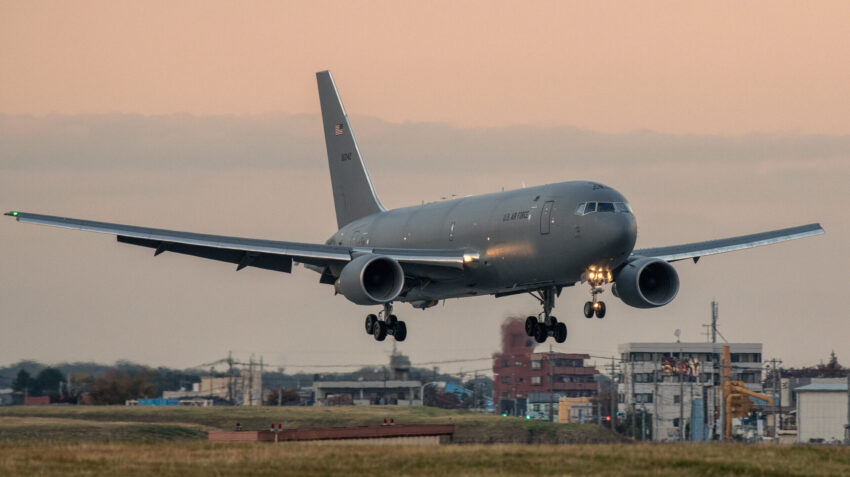A KC-46 Pegasus assigned to the 22nd Air Refueling Wing, McConnell Air Force Base, Kansas, lands at Yokota Air Base, Japan, Nov. 7, 2022, in support of Exercise Keen Sword 23. (U.S. Air Force photo by Yasuo Osakabe)
WASHINGTON — Just two years after unveiling a new tanker strategy that would involve the development of a futuristic stealthy tanker, the Air Force is yet again shifting course for its air refueling fleet, and is now eyeing a novel program to extend tanker production — a move that could favor Boeing’s KC-46 Pegasus.
The refreshed tanker plan, unveiled in fiscal 2026 budget documents recently released by the Defense Department, calls for a “Tanker Production Extension” program, set to launch next year. The Air Force is requesting $23.8 million for the effort, which should finish developing a request for proposals by the third quarter of FY26, according to the documents.
It’s not clear what the Air Force will ultimately decide for the new production extension program. One path would involve a competition that could draw rival bids for the KC-46 from industry players like Airbus and Embraer who have previously expressed interest in providing the service’s tanker needs. Whatever is ultimately picked for this new extension program would start production after Boeing completes deliveries under its current KC-46 contract, which is expected to conclude around the end of this decade.
However, it is also possible the Air Force simply decides to buy more KC-46s, either as a result of a competition or as a sole-source selection. Notably, the budget documents say that the Air Force will use the Pegasus’s Capability Production Document “as the most affordable requirements basis” for the production extension effort.
The new production extension plan supplants a previous strategy dubbed the KC-135 Tanker Recapitalization Program, which officials in 2023 explained would continue replacements of the aging KC-135 until a futuristic tanker dubbed the Next-Generation Air Refueling System (NGAS) could be fielded.
The NGAS platform itself — previously described as a clean-sheet design that would incorporate low-observable features, offering more survivability than current platforms that are derived from commercial aircraft — is now in doubt under the Trump administration budget, which requests about $13 million in FY26 to continue analysis of alternatives work and explore ways to incorporate new mission systems to enhance tanker self-protection.
Asked previously about NGAS plans, an Air Force spokesperson told Breaking Defense on June 26 that the roughly $13 million funding line would “preserve research and development in cross-platform High Value Airborne Assets (HVAA) connectivity and survivability initiatives,” and that NGAS “analysis is ongoing as the Air Force seeks to address legacy and future tanker fleet survivability overall.”
The new tanker strategy could also reflect a decision by the service to return to previous refueler expectations. When the Tanker Recapitalization Program and NGAS plans were announced, the Air Force’s then-top acquisition official said the service was leaning toward procuring the KC-46 as a near-term solution to continue replacing the KC-135.
The new strategy marks the latest twist in the service’s ever-evolving tanker saga, which has seen its own shifts in the industry side as well. Lockheed Martin, for example, planned to partner with Airbus for a tanker contract using the latter’s A330 Multi-Role Tanker Transport, but Lockheed ultimately bowed out in late 2023. Airbus subsequently said it would remain engaged with the Air Force on its tanker plans. Meanwhile, Embraer has launched an aggressive campaign to get the US Air Force to sign on to its KC-390, alongside pledges to manufacture the plane in the US if selected.
The Air Force in the meantime is investing heavily in the KC-46 platform, whose deliveries recently restarted after a months-long pause. The Air Force is requesting roughly $81.2 million for KC-46 upgrades in FY26, the budget documents say, and the Air Force spokesperson told Breaking Defense the service also expects to increase the Pegasus’s program of record to 188 aircraft, the maximum available under the current contract with Boeing.
RELATED: KC-46 refueling vision system fix delayed to 2027
A “risk reduction study” for a new Block II upgrade program for the Pegasus would also be launched in FY26, the documents say, which would entail “communication and navigation systems” enhancements. A current Block I effort that will equip the KC-46 with updated secure communications capabilities is expected to complete in the second quarter of FY28, the documents say.
Boeing has lost billions of dollars on the Pegasus program due to a fixed-price contract the company agreed to with the Air Force, though future orders could help the beleaguered plane maker alleviate some of that financial toll.
Click this link for the original source of this article.
Author: Michael Marrow
This content is courtesy of, and owned and copyrighted by, https://breakingdefense.com and its author. This content is made available by use of the public RSS feed offered by the host site and is used for educational purposes only. If you are the author or represent the host site and would like this content removed now and in the future, please contact USSANews.com using the email address in the Contact page found in the website menu.








